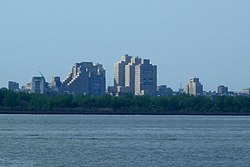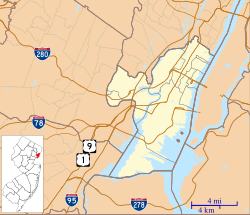Beacon, Jersey City
|
Jersey City Medical Center
|
|

From the harbor
|
|
| Location | Roughly bounded by Montgomery Street, Cornelison Avenue, Dupont Street and Clifton Place, and Baldwin Avenue, Jersey City, New Jersey |
|---|---|
| Coordinates | 40°43′20″N 74°3′51″W / 40.72222°N 74.06417°WCoordinates: 40°43′20″N 74°3′51″W / 40.72222°N 74.06417°W |
| NRHP Reference # | 85003057 |
| NJRHP # | 1515 |
| Significant dates | |
| Added to NRHP | November 27, 1985 |
| Designated NJRHP | March 19, 1985 |
The Beacon is a new mixed-use development emerging from the rehabilitation of the original complex of the Jersey City Medical Center that also restores historical features of the exterior façades and public interior spaces. It is located on a 14-acre (57,000 m2) site on Bergen Hill, a crest of the Hudson Palisades and one of the highest geographical points in Jersey City, in Hudson County, New Jersey, United States. It creates the northeastern corner the Bergen Lafayette Section and is just east of McGinley Square. It includes 2,000,000 square feet (190,000 m2) of residential and retail space, approximately 1,200 luxury residences and 80,000 square feet (7,400 m2) of retail space. The redevelopment stalled after a down-turn in the market, but was completed by April 2016.
The hospital began as the "Charity Hospital" by the Board of Aldermen of Jersey City who bought land at Baldwin Avenue and Montgomery Street in 1882 for a new hospital. The locale was chosen to remove the hospital from the industrial development at Paulus Hook. This building is now the Medical Center building. It was renamed the Jersey City Hospital in 1885 and had expanded to 200 beds. In 1909, the original hospital building was reserved for men and a second wing was added for women. When Frank Hague became mayor of Jersey City in 1917, he planned to expand the hospital. He had the original building renovated, and by the late 1920's started construction on a new 23-story structure for surgery. The new facility opened in 1931, and George O'Hanlon was the first director.
During the Great Depression, new buildings were added as a Works Progress Administration project secured by Mayor Frank Hague, The Jersey City Medical Center included such architectural and designer trappings as marble walls, terrazzo floors, etched glass, decorative moldings and glittering chandeliers, and had one of the most famous maternity wards in the country – the Margaret Hague Maternity Hospital. The original main hospital building was demolished to make way for two new hi-rise structures. The formal dedication of the Medical Center Complex, including the new B. S. Pollack Hospital building, was on October 2, 1936, with Franklin D. Roosevelt dedicating the building. During the 1950s, JCMC was the home of the medical school of Seton Hall University, which later became the New Jersey Medical School, now located in Newark. Oversized and understaffed, in 1988 the Medical Center declared bankruptcy and became a private, non-profit organization. In 1994, the State of New Jersey designated the Medical Center as a regional trauma center, and in the late 1990s it was approved as a core teaching affiliate of Icahn School of Medicine at Mount Sinai. The hospital and offices moved to a new complex in 2004. Prior to that, one building of the complex, 591 Montgomery Street had been converted for senior assisted-living residence.
...
Wikipedia

